A while ago I put a call out for you guys to let me know the kinds of things you’d like to pick my brain about creatively speaking, not necessarily only in a ‘teaching’ format, but also more generally here on the blog.
The most common questions currently are about sketchbooks.
How do I use them? Do I keep several going at once? What do I fill them with? Do I use them to practice or to plan paintings? How can sketchbook time be incorporated into a busy life?
Great questions, and as usual, I have plenty to share on the subject. 🙂
Bear in mind of course that every artist will probably tell you something different, since there are as many approaches as there are artists, each of us being unique and everything.
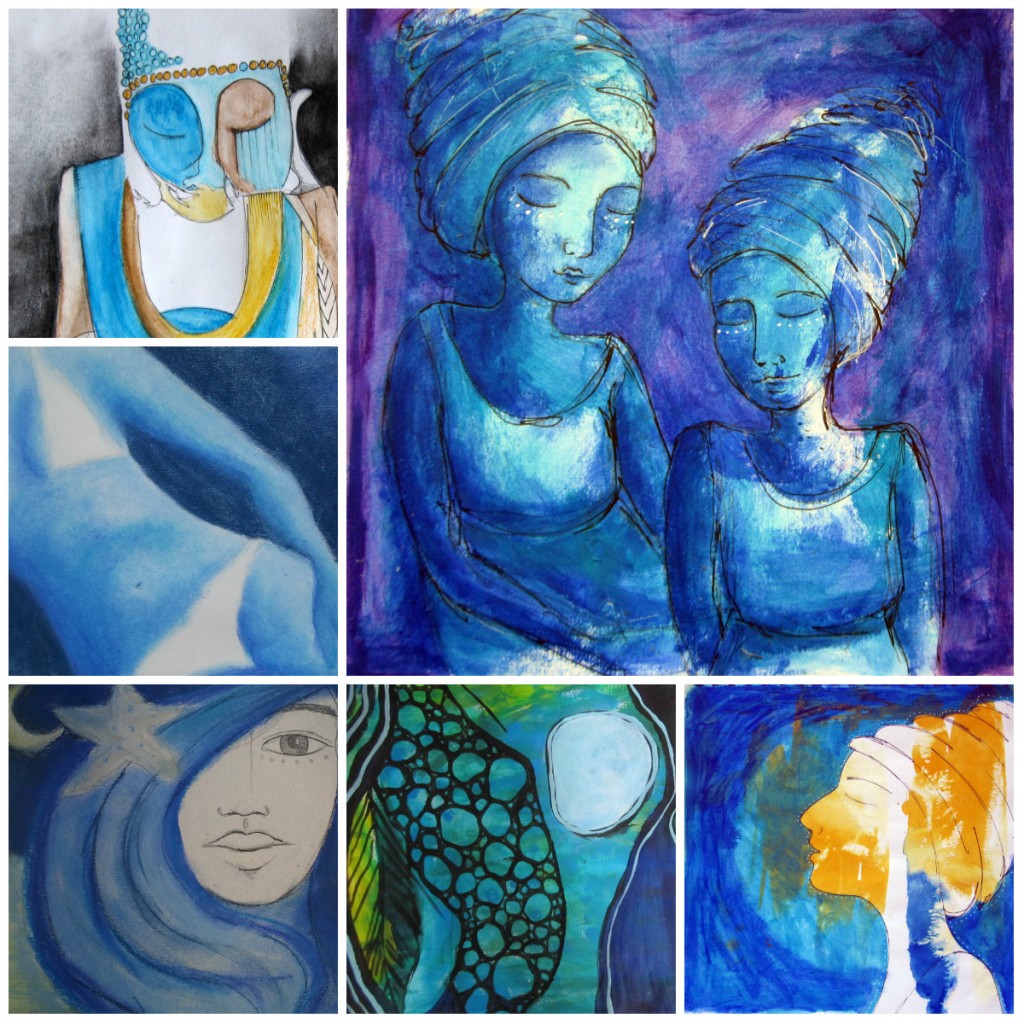
sketchbook snippets: clockwise from top left ~ a blind contour Buddha drawing; figures drawn over background made with left over paint; drawing over ink blot and paint smudges; intuitive painting; soft pastels + pencil; soft pastels
What kind of sketchbooks do I use?
I prefer large and square, as I talked about here, although I recently discovered a super-size rectangle version {below} of my favourite ring bound square ones which I’m really enjoying using. I don’t tend to paint in them, except for using watercolour pencils and a wet brush; it’s usually just pencil, charcoal and pastels.
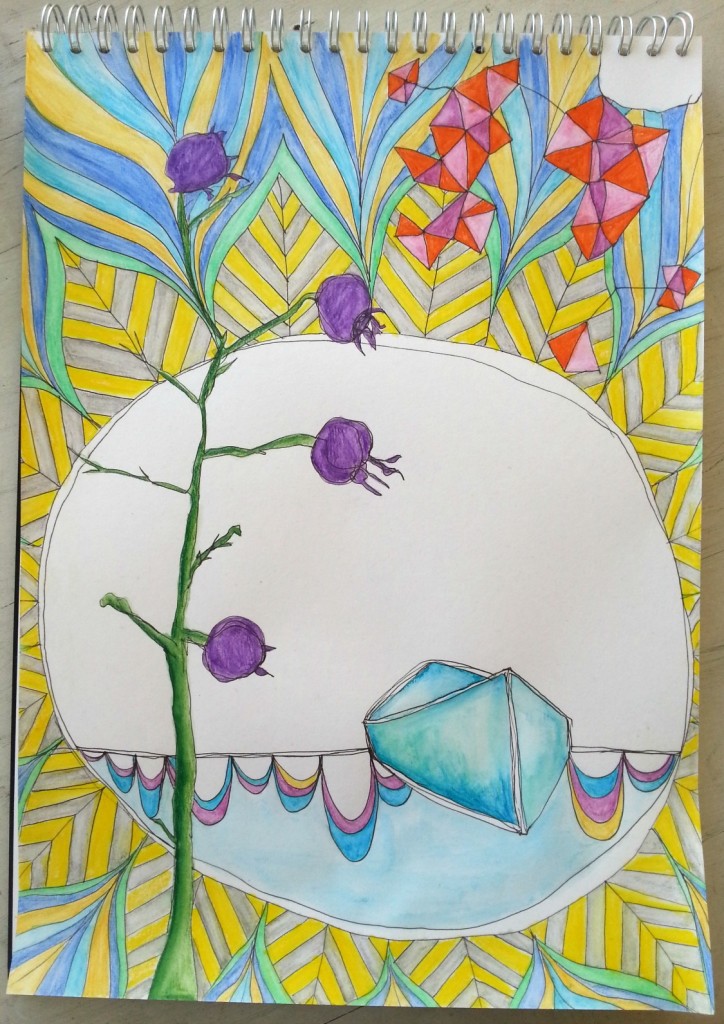
playing in my new large sketchbook; these images were all inspired by Instagram photos and then combined. i’ve been adding a little to it most evenings
How do I find/create time to play in my sketchbook?
It’s very easy to feel there’s always something more important to be doing than drawing, especially for no determined outcome, even though it has good side effects like calmness, wellbeing, exploration of ideas and pleasure. This is what I’ve found helpful to bypass the excuses and fit in sketchbook time when I’m really busy;
a} I carry a little one around with me, with just a pencil and maybe an eraser. That way it’s at the ready if I’m waiting for an appointment, or have some other pause in my day.
b} Doubling up: doodling while watching something in the evening, sketching something out while I eat my lunch, or on a coffee break.
c} Viewing it as one of my self care activities; I know I enjoy it {usually!} so not doing it means I’m either prioritising less important-to-me things, or I just don’t feel like it {also totally valid}. But if I have an idea I want to get down or just feel like playing with some colour, I will find a way to fit it in. A happy me means a happier everyone I come into contact with. 🙂
d} I don’t have kids but if I did you can bet they’d be a great ‘excuse’ for plenty of playtime artistically speaking!
4 Ways I Use My Sketchbooks
I’ve divided my main personal usage of sketchbooks into four main sections, since I am using my sketchbooks for different reasons at different times.
sketchbook mining
This is a great thing to do when you’re not feeling inspired but are feeling itchy to do something arty. I sometimes go back through old sketchbooks to find ideas I never finished, or borrow images for a painting. It’s very easy to forget what you love doing, and mining is great for reminding me of how much I love creating a certain type of image. It’s fun to see what you used to like drawing and how that’s changed, too. I sometimes go back and colour things in if I’m feeling creatively low key.
Another thing about going back is that I often create backgrounds when I have paint left over from a painting and don’t want to waste it. I can go back to these pre-made pages as they give me something to start from.

these three pages are an example of sketchbook mining; the left and right drawings were just pencil sketches, which I later went back and coloured in for fun. i then mined some of my poems to use for practising lettering with a feather and ink {a top three fave} and ended up very happy with the results. cross pollination like this is a great way to create something different. the central drawing is a ‘mined’ background.
working stuff out
This is one of my more common uses for sketchbooks; sometimes I have an idea or an image in my head but I’m not sure how it’ll look on paper or canvas, or I don’t know if I’m able to draw it or if it’ll feel fun to draw, so I might need to try out some things to get the look I want.
Recently I’ve found myself very inspired by various Instagram images, and playing with ideas they provoke. I also make notes in my sketchbooks, as I am frequently inspired by words as well as images, or I might jot down names of artists or genres I want to explore.
planning paintings
I rarely do this, although I know it’s actually a very common use for sketchbooks. I think it’s partly because I don’t plan my paintings really, beyond percolating ideas in my head and having a very rough idea before I start. Also my boredom threshold is incredibly low so I never want to do the same thing twice. Ever. That said, I have used sketches as springboards for painting ideas, it’s just not my main use for them.
evening playing
This is my current favourite use for my sketchbooks, since it’s winter and evenings can be happily spent cosed up on the sofa with my coffee table art kit and something on Netflix. Obviously playing is not restricted to evenings! Sometimes I like to take some supplies to the beach and play there.
Another thing I love about sketchbooks is that you can try out different styles of making art, from art journalling to more traditional life drawing. Blind contour drawing is one of my favourite things to do because it renders images into something unique and quirky, and it allows me to sidestep getting tangled up in struggling to be accurate, which is a fast way to take all the fun out of it.
Below are some random images from past sketchbooks, which as you will see show me trying out very diverse ways of making art. And of course there are plenty of pages I don’t finish, or don’t like, and that’s ok. We are not obliged to share or use everything! I also have several sketchbooks on the go, as with paintings. That gives me plenty of half finished things to play with and keeps the inspiration flowing.
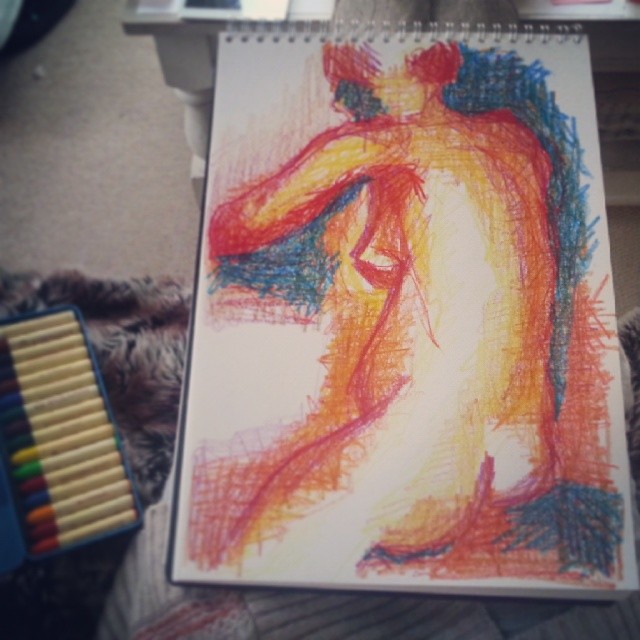
a recent play session in the large sketchbook involving some beeswax crayons i was given. i used a reference image but it was more about testing the crayons and seeing how they work together than trying to make a good drawing
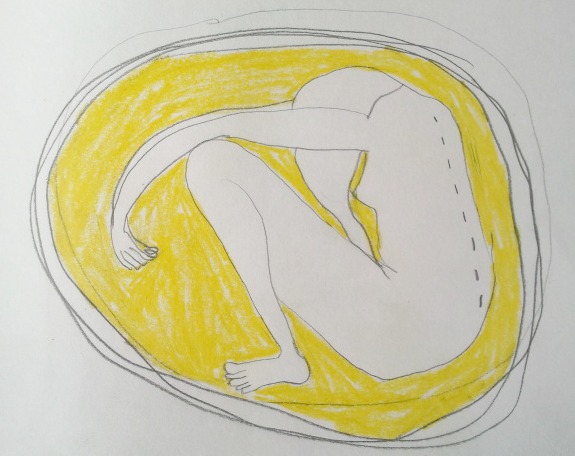
a random line drawing from my imagination utilising the kind of quirky weirdness i really enjoy. i went back later and coloured it.

L-R: ink and feather drawings inspired by an instagram image by Jill Bliss on an old ink blot background; one of my favourite images to draw, coloured in with pastel pencils; an ink blot drawing inspired by Leah Piken Kolidas’s paintings
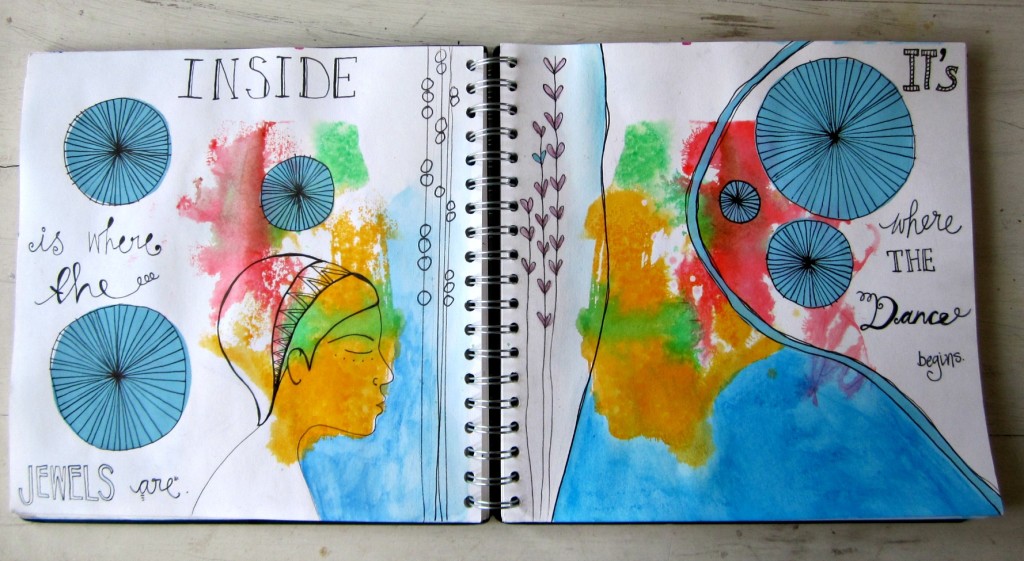
a double spread using old ink blots and playing with lettering using one of my poems again. also indulging my love of circles.
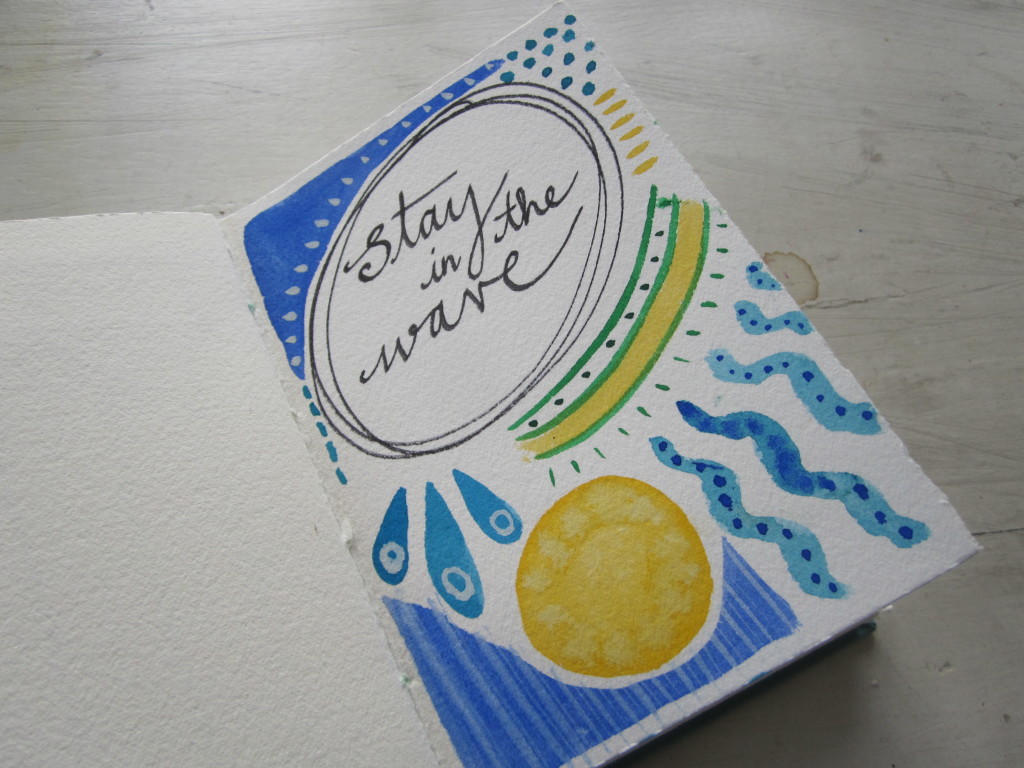
a rare tiny sketchbook entry; this was inspired by an artist whose work i’ve seen on instagram, as well as a reminder to myself
If you’ve got this far ~ yay you! I hope some of these insights into how I use my sketchbooks take some of the mystery out of it, or prove useful or inspiring.
For me, sketchbooks are about fun, exploration and play, rather than being somewhere I ‘practice to perfect’. If I were to make it a discipline or something scheduled, I’d never use them! If you have any more questions or would like to share how YOU use sketchbooks, please feel free to do so in the comments. I’d love to hear from you!
************

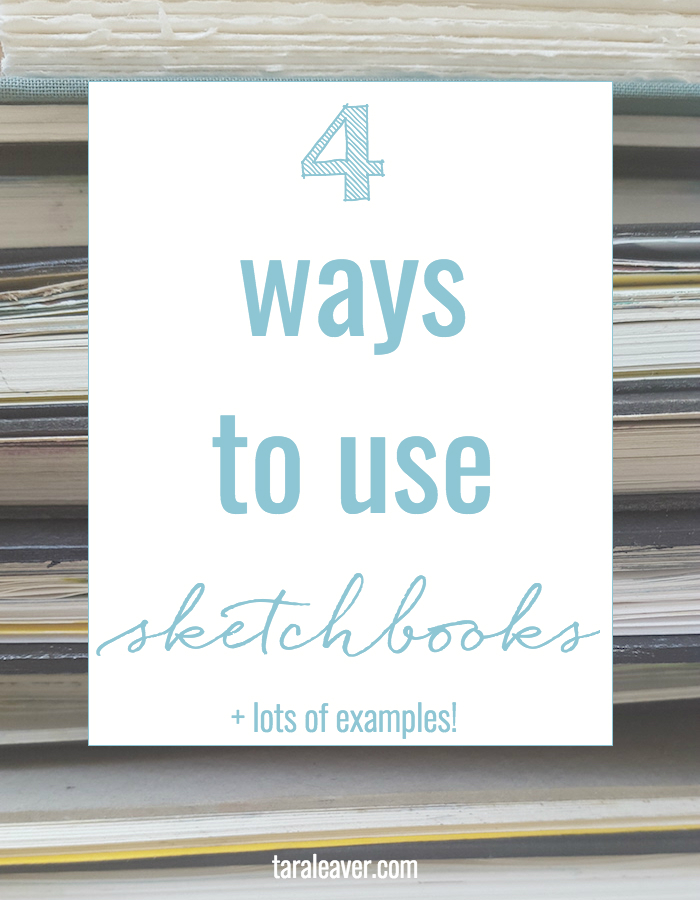







Such lovely and inspiring images, my friend! Thank you for sharing.
Thank you Malini!
wow, these are gorgeous….your sketches, unfinished as they might be :), are SO beautiful. I would buy them all 🙂 I especially love the three small sets of three…together they look so beautiful!!!
Thank you so much Eliza. Nothing like a Picmonkey collage. 😉
How lovely! Thanks for sharing – this was such an inspiration to me!
Great! I’m so pleased. 🙂
Love your sketchbook pages. I don’t do enough of just playing – you’ve inspired me to do more!
I’m so pleased you feel inspired Bev! That’s all I could wish for.
Fabulous thank you for sharing!
I’m glad you enjoyed it Michelle!
Tara, I really love your sketches and paintings – I really connect with them. Thank you for sharing – even the unfinished ones are gorgeous and it’s so great to see the process in your sketchbooks. I so relate to that tendency to tell ourselves we need to be doing more important stuff…. and yet we so need this to feed our souls and make everything else possible.
Thank you Vicky, I love that you feel a connection to them, that’s lovely! Also, ‘we so need this to feed our souls and make everything else possible’ ~ exactly! Beautifully put.
Love this sneak peek.
I’ve been meaning to blog about the various books I work in at any one time too.
Big Love
Gxx
Oh, I’d love to see in your sketchbooks Galia! You use them in a much different way than me I think, and I love the way you use so much symbolism.
An inspiring piece; normally I just launch into something but I really should make use of a sketchbook!
I think if just launching in works for you – and I do that too with probably most of my paintings – then that’s perfect for you! Sketchbooks can definitely make art more portable, and can be a ‘pressure off’ place to play, but it’s really about what works best for each of us. Thanks for stopping by Paul!
So inspiring! I love taking a peek into artists sketch books…now I’m going to get out my own!
Marvellous! Glad to have inspired you, and thank you for stopping by Henrietta!
Hi Tara, found you thru Connie. Thank you for sharing this about sketchbooks. I think this is the best explanation I have read. I know 21 Secrets is for the women but I am a male and Connie is a big inspiration to me. Thanks again and I look forward to enjoying your posts.
Hi Chris, thank you so much for stopping by and I’m glad you enjoyed the post. 21 Secrets, and art journaling in general, isn’t just for women of course, although I imagine it might feel a little overwhelmingly as though it is! 🙂
Thank-you for reminding me that sketchbooks are supposed to be fun! I get too serious, try too hard, and forget to enjoy the process. Today I will revive my coffee table art kit ( which I originally learned from you) team it it with one of my many unfinished sketchbooks, and play!
Ha yes, it can be so easy to tip over into the more stressful side of things! So glad you found something useful here Louisa – sounds like an excellent plan!